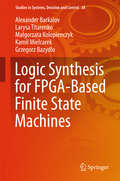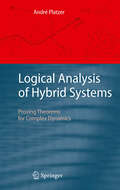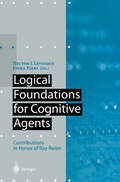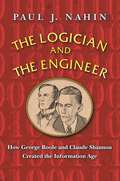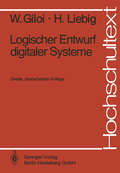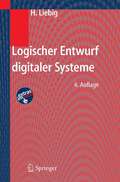- Table View
- List View
Logic Synthesis for Field-Programmable Gate Arrays (The Springer International Series in Engineering and Computer Science #324)
by Rajeev Murgai Robert K. Brayton Alberto L. Sangiovanni-VincentelliShort turnaround has become critical in the design of electronic systems. Software- programmable components such as microprocessors and digital signal processors have been used extensively in such systems since they allow rapid design revisions. However, the inherent performance limitations of software-programmable systems mean that they are inadequate for high-performance designs. Designers thus turned to gate arrays as a solution. User-programmable gate arrays (field-programmable gate arrays, FPGAs) have recently emerged and are changing the way electronic systems are designed and implemented. The growing complexity of the logic circuits that can be packed onto an FPGA chip means that it has become important to have automatic synthesis tools that implement logic functions on these architectures. Logic Synthesis for Field-Programmable Gate Arrays describes logic synthesis for both look-up table (LUT) and multiplexor-based architectures, with a balanced presentation of existing techniques together with algorithms and the system developed by the authors. Audience: A useful reference for VLSI designers, developers of computer-aided design tools, and anyone involved in or with FPGAs.
Logic Synthesis for Finite State Machines Based on Linear Chains of States: Foundations, Recent Developments and Challenges (Studies in Systems, Decision and Control #113)
by Alexander Barkalov Larysa Titarenko Jacek BieganowskiThis book discusses Moore finite state machines (FSMs) implemented with field programmable gate arrays (FPGAs) including look-up table (LUT) elements and embedded memory blocks (EMBs). To minimize the number of LUTs in FSM logic circuits, the authors propose replacing a state register with a state counter. They also put forward an approach allowing linear chains of states to be created, which simplifies the system of input memory functions and, therefore, decreases the number of LUTs in the resulting FSM circuit. The authors combine this approach with using EMBs to implement the system of output functions (microoperations). This allows a significant decrease in the number of LUTs, as well as eliminating a lot of interconnections in the FSM logic circuit. As a rule, it also reduces the area occupied by the circuit and diminishes the resulting power dissipation.This book is an interesting and valuable resource for students and postgraduates in the area of computer science, as well as for designers of digital systems that included complex control units
Logic Synthesis for FPGA-Based Control Units: Structural Decomposition in Logic Design (Lecture Notes in Electrical Engineering #636)
by Alexander Barkalov Larysa Titarenko Kamil Mielcarek Sławomir ChmielewskiThis book focuses on control units, which are a vital part of modern digital systems, and responsible for the efficiency of controlled systems. The model of a finite state machine (FSM) is often used to represent the behavior of a control unit. As a rule, control units have irregular structures that make it impossible to design their logic circuits using the standard library cells. Design methods depend strongly on such factors as the FSM used, specific features of the logic elements implemented in the FSM logic circuit, and the characteristics of the control algorithm to be interpreted.This book discusses Moore and Mealy FSMs implemented with FPGA chips, including look-up table elements (LUT) and embedded memory blocks (EMB). It is crucial to minimize the number of LUTs and EMBs in an FSM logic circuit, as well as to make the interconnections between the logic elements more regular, and various methods of structural decompositions can be used to solve this problem. These methods are reduced to the presentation of an FSM circuit as a composition of different logic blocks, the majority of which implement systems of intermediate logic functions different (and much simpler) than input memory functions and FSM output functions. The structural decomposition results in multilevel FSM circuits having fewer logic elements than equivalent single-level circuits. The book describes well-known methods of structural decomposition and proposes new ones, examining their impact on the final amount of hardware in an FSM circuit. It is of interest to students and postgraduates in the area of Computer Science, as well as experts involved in designing digital systems with complex control units. The proposed models and design methods open new possibilities for creating logic circuits of control units with an optimal amount of hardware and regular interconnections.
Logic Synthesis for FPGA-Based Finite State Machines (Studies in Systems, Decision and Control #38)
by Alexander Barkalov Larysa Titarenko Malgorzata Kolopienczyk Kamil Mielcarek Grzegorz BazydloThis book discusses control units represented by the model of a finite state machine (FSM). It contains various original methods and takes into account the peculiarities of field-programmable gate arrays (FPGA) chips and a FSM model. It shows that one of the peculiarities of FPGA chips is the existence of embedded memory blocks (EMB). The book is devoted to the solution of problems of logic synthesis and reduction of hardware amount in control units. The book will be interesting and useful for researchers and PhD students in the area of Electrical Engineering and Computer Science, as well as for designers of modern digital systems.
Logic Synthesis for FSM-Based Control Units (Lecture Notes in Electrical Engineering #53)
by Alexander Barkalov Larysa TitarenkoLogic Synthesis for Genetic Diseases: Modeling Disease Behavior Using Boolean Networks
by Pey-Chang Kent Lin Sunil P. KhatriThis book brings to bear a body of logic synthesis techniques, in order to contribute to the analysis and control of Boolean Networks (BN) for modeling genetic diseases such as cancer. The authors provide several VLSI logic techniques to model the genetic disease behavior as a BN, with powerful implicit enumeration techniques. Coverage also includes techniques from VLSI testing to control a faulty BN, transforming its behavior to a healthy BN, potentially aiding in efforts to find the best candidates for treatment of genetic diseases.
Logic Synthesis for Low Power VLSI Designs
by Sasan Iman Massoud PedramLogic Synthesis for Low Power VLSI Designs presents a systematic and comprehensive treatment of power modeling and optimization at the logic level. More precisely, this book provides a detailed presentation of methodologies, algorithms and CAD tools for power modeling, estimation and analysis, synthesis and optimization at the logic level. Logic Synthesis for Low Power VLSI Designs contains detailed descriptions of technology-dependent logic transformations and optimizations, technology decomposition and mapping, and post-mapping structural optimization techniques for low power. It also emphasizes the trade-off techniques for two-level and multi-level logic circuits that involve power dissipation and circuit speed, in the hope that the readers can better understand the issues and ways of achieving their power dissipation goal while meeting the timing constraints. Logic Synthesis for Low Power VLSI Designs is written for VLSI design engineers, CAD professionals, and students who have had a basic knowledge of CMOS digital design and logic synthesis.
Logic Synthesis for VLSI-Based Combined Finite State Machines: Synthesis Targeting ASICs, CPLDs and FPGAs (Lecture Notes in Electrical Engineering #922)
by Alexander Barkalov Larysa Titarenko Kamil Mielcarek Małgorzata Mazurkiewicz Elżbieta KaweckaThe book is devoted to design and optimization of control units represented by combined finite state machines (CFSMs). The CFSMs combine features of both Mealy and Moore FSMs. Having states of Moore FSM, they produce output signals of both Mealy and Moore types. To optimize the circuits of CFSMs, we propose to use optimization methods targeting both Mealy and Moore FSMs. The book contains some original synthesis and optimization methods targeting hardware reduction in VLSI-based CFSM circuits. These methods take into account the peculiarities of both a CFSM model and a VLSI chip in use. The optimization is achieved due to combining classical optimization methods with new methods proposed in this book. These new methods are a mixed encoding of collections of microoperations and a twofold state assignment in CFSMs. All proposed methods target reducing the numbers of arguments in systems of Boolean functions representing CFSM circuits. Also, we propose to use classes of pseudoequivalent states of Moore FSMs to reduce the number of product terms in these systems.The book includes a lot of examples which contributes to a better understanding of the features of the synthesis methods under consideration. This is the first book entirely devoted to the problems associated with synthesis and optimization of VLSI-based CFSMs. We hope that the book will be interesting and useful for students and PhD students in the area of Computer Science, as well as for designers of various digital systems. We think that proposed CFSM models enlarge the class of models applied for implementation of control units with modern VLSI chips.
Logic Synthesis Using Synopsys®
by Pran Kurup Taher AbbasiLogic synthesis has become a fundamental component of the ASIC design flow, and Logic Synthesis Using Synopsys® has been written for all those who dislike reading manuals but who still like to learn logic synthesis as practised in the real world. The primary focus of the book is Synopsys Design Compiler®: the leading synthesis tool in the EDA marketplace. The book is specially organized to assist designers accustomed to schematic capture based design to develop the required expertise to effectively use the Compiler. Over 100 `classic scenarios' faced by designers using the Design Compiler have been captured and discussed, and solutions provided. The scenarios are based both on personal experiences and actual user queries. A general understanding of the problem-solving techniques provided will help the reader debug similar and more complicated problems. Furthermore, several examples and dc-shell scripts are provided. Specifically, Logic Synthesis Using Synopsys® will help the reader develop a better understanding of the synthesis design flow, optimization strategies using the Design Compiler, test insertion using the Test Compiler®, commonly used interface formats such as EDIF and SDF, and design re-use in a synthesis-based design methodology. Examples have been provided in both VHDL and Verilog. Audience: Written with CAD engineers in mind to enable them to formulate an effective synthesis-based ASIC design methodology. Will also assist design teams to better incorporate and effectively integrate synthesis with their existing in-house design methodology and CAD tools.
Logic Synthesis Using Synopsys®
by Pran Kurup Taher AbbasiLogic Synthesis Using Synopsys®, Second Edition is for anyone who hates reading manuals but would still like to learn logic synthesis as practised in the real world. Synopsys Design Compiler, the leading synthesis tool in the EDA marketplace, is the primary focus of the book. The contents of this book are specially organized to assist designers accustomed to schematic capture-based design to develop the required expertise to effectively use the Synopsys Design Compiler. Over 100 `Classic Scenarios' faced by designers when using the Design Compiler have been captured, discussed and solutions provided. These scenarios are based on both personal experiences and actual user queries. A general understanding of the problem-solving techniques provided should help the reader debug similar and more complicated problems. In addition, several examples and dc_shell scripts (Design Compiler scripts) have also been provided. Logic Synthesis Using Synopsys®, Second Edition is an updated and revised version of the very successful first edition. The second edition covers several new and emerging areas, in addition to improvements in the presentation and contents in all chapters from the first edition. With the rapid shrinking of process geometries it is becoming increasingly important that `physical' phenomenon like clusters and wire loads be considered during the synthesis phase. The increasing demand for FPGAs has warranted a greater focus on FPGA synthesis tools and methodology. Finally, behavioral synthesis, the move to designing at a higher level of abstraction than RTL, is fast becoming a reality. These factors have resulted in the inclusion of separate chapters in the second edition to cover Links to Layout, FPGA Synthesis and Behavioral Synthesis, respectively. Logic Synthesis Using Synopsys®, Second Edition has been written with the CAD engineer in mind. A clear understanding of the synthesis tool concepts, its capabilities and the related CAD issues will help the CAD engineer formulate an effective synthesis-based ASIC design methodology. The intent is also to assist design teams to better incorporate and effectively integrate synthesis with their existing in-house design methodology and CAD tools.
Logical Analysis of Hybrid Systems: Proving Theorems for Complex Dynamics
by André PlatzerHybrid systems are models for complex physical systems and have become a widely used concept for understanding their behavior. Many applications are safety-critical, including car, railway, and air traffic control, robotics, physical–chemical process control, and biomedical devices. Hybrid systems analysis studies how we can build computerized controllers for physical systems which are guaranteed to meet their design goals. The author gives a unique, logic-based perspective on hybrid systems analysis. It is the first book that leverages the power of logic for hybrid systems. The author develops a coherent logical approach for systematic hybrid systems analysis, covering its theory, practice, and applications. It is further shown how the developed verification techniques can be used to study air traffic and railway control systems. This book is intended for researchers, postgraduates, and professionals who are interested in hybrid systems analysis, cyberphysical or embedded systems design, logic and theorem proving, or transportation and automation.
Logical Foundations for Cognitive Agents: Contributions in Honor of Ray Reiter (Artificial Intelligence)
by Hector J. Levesque Fiora PirriIt is a pleasure and an honor to be able to present this collection of papers to Ray Reiter on the occasion of his 60th birthday. To say that Ray's research has had a deep impact on the field of Artificial Intel ligence is a considerable understatement. Better to say that anyone thinking of do ing work in areas like deductive databases, default reasoning, diagnosis, reasoning about action, and others should realize that they are likely to end up proving corol laries to Ray's theorems. Sometimes studying related work makes us think harder about the way we approach a problem; studying Ray's work is as likely to make us want to drop our way of doing things and take up his. This is because more than a mere visionary, Ray has always been a true leader. He shows us how to proceed not by pointing from his armchair, but by blazing a trail himself, setting up camp, and waiting for the rest of us to arrive. The International Joint Conference on Ar tificial Intelligence clearly recognized this and awarded Ray its highest honor, the Research Excellence award in 1993, before it had even finished acknowledging all the founders of the field. The papers collected here sample from many of the areas where Ray has done pi oneering work. One of his earliest areas of application was databases, and this is re flected in the chapters by Bertossi et at. and the survey chapter by Minker.
Logical Foundations for Rule-Based Systems (Studies in Computational Intelligence #11)
by Antoni LigezaThinking in terms of facts and rules is perhaps one of the most common ways of approaching problem de?nition and problem solving both in everyday life and under more formal circumstances. The best known set of rules, the Ten Commandments have been accompanying us since the times of Moses; the Decalogue proved to be simple but powerful, concise and universal. It is logically consistent and complete. There are also many other attempts to impose rule-based regulations in almost all areas of life, including professional work, education, medical services, taxes, etc. Some most typical examples may include various codes (e.g. legal or tra?c code), regulations (especially military ones), and many systems of customary or informal rules. The universal nature of rule-based formulation of behavior or inference principles follows from the concept of rules being a simple and intuitive yet powerful concept of very high expressive power. Moreover, rules as such encode in fact functional aspects of behavior and can be used for modeling numerous phenomena.
Logical Foundations of Cyber-Physical Systems
by André PlatzerCyber-physical systems (CPSs) combine cyber capabilities, such as computation or communication, with physical capabilities, such as motion or other physical processes. Cars, aircraft, and robots are prime examples, because they move physically in space in a way that is determined by discrete computerized control algorithms. Designing these algorithms is challenging due to their tight coupling with physical behavior, while it is vital that these algorithms be correct because we rely on them for safety-critical tasks. This textbook teaches undergraduate students the core principles behind CPSs. It shows them how to develop models and controls; identify safety specifications and critical properties; reason rigorously about CPS models; leverage multi-dynamical systems compositionality to tame CPS complexity; identify required control constraints; verify CPS models of appropriate scale in logic; and develop an intuition for operational effects. The book is supported with homework exercises, lecture videos, and slides.
Logically Determined Design: Clockless System Design with NULL Convention Logic
by Karl M. FantThis seminal book presents a new logically determined design methodology for designing clockless circuit systems. The book presents the foundations, architectures and methodologies to implement such systems. Based on logical relationships, it concentrates on digital circuit system complexity and productivity to allow for more reliable, faster and cheaper products. * Transcends shortcomings of Boolean logic. * Presents theoritical foundations, architecture and analysis of clockless (asynchronous) circuit design. * Contains examples and exercises making it ideal for those studying the area.
The Logician and the Engineer: How George Boole and Claude Shannon Created the Information Age
by Paul J. NahinBoolean algebra, also called Boolean logic, is at the heart of the electronic circuitry in everything we use—from our computers and cars, to home appliances. How did a system of mathematics established in the Victorian era become the basis for such incredible technological achievements a century later? In The Logician and the Engineer, Paul Nahin combines engaging problems and a colorful historical narrative to tell the remarkable story of how two men in different eras—mathematician and philosopher George Boole and electrical engineer and pioneering information theorist Claude Shannon—advanced Boolean logic and became founding fathers of the electronic communications age. Nahin takes readers from fundamental concepts to a deeper and more sophisticated understanding of modern digital machines, in order to explore computing and its possible limitations in the twenty-first century and beyond.
The Logician and the Engineer: How George Boole and Claude Shannon Created the Information Age
by Paul J. NahinBoolean algebra, also called Boolean logic, is at the heart of the electronic circuitry in everything we use—from our computers and cars, to home appliances. How did a system of mathematics established in the Victorian era become the basis for such incredible technological achievements a century later? In The Logician and the Engineer, Paul Nahin combines engaging problems and a colorful historical narrative to tell the remarkable story of how two men in different eras—mathematician and philosopher George Boole and electrical engineer and pioneering information theorist Claude Shannon—advanced Boolean logic and became founding fathers of the electronic communications age. Nahin takes readers from fundamental concepts to a deeper and more sophisticated understanding of modern digital machines, in order to explore computing and its possible limitations in the twenty-first century and beyond.
Logics for Computer and Data Sciences, and Artificial Intelligence (Studies in Computational Intelligence #992)
by Lech T. PolkowskiThis volume offers the reader a systematic and throughout account of branches of logic instrumental for computer science, data science and artificial intelligence. Addressed in it are propositional, predicate, modal, epistemic, dynamic, temporal logics as well as applicable in data science many-valued logics and logics of concepts (rough logics). It offers a look into second-order logics and approximate logics of parts.The book concludes with appendices on set theory, algebraic structures, computability, complexity, MV-algebras and transition systems, automata and formal grammars.By this composition of the text, the reader obtains a self-contained exposition that can serve as the textbook on logics and relevant disciplines as well as a reference text.
Logikkalküle (Leitfäden der angewandten Mathematik und Mechanik - Teubner Studienbücher #43)
by Michael M. RichterLogische Grundlagen der Künstlichen Intelligenz (Künstliche Intelligenz)
by Nils J. NilssonDas Buch ist die deutsche Übersetzung des Standardwerkes der Stanforder Professoren Michael R. Genesereth und Nils J. Nilsson.Im Unterschied zu deutschen Lehrbüchern der Informatik zeichnet sich das Buch dadurch aus, daß es einen gut lesbaren Überblick gibt, ohne allzu formalistisch zu werden, gleichwohl aber von hohem Niveau ist und die Ergebnisse jüngster Forschung berücksichtigt. Das Buch empfiehlt sich sowohl für Studenten und Dozenten der Inf ormatik, aber auch für Forscher aus anderen Gebieten, die von den Grundlagen der Künstlichen Intelligenz profitieren möchten.
Logischer Entwurf digitaler Systeme (Hochschultext)
by Wolfgang Giloi Hans LiebigBücher über die Arbeitsweise und den Entwurf logischer oder digitaler Systeme weisen unserer Meinung nach häufig einen Schönheitsfehler auf (manche mehr, manche weniger): sie trennen zu wenig die Betrachtung des funktionellen Ver haltens solcher Systeme von der Betrachtung ihres tee h n i sc he n Verhaltens. Das Standardbuch über Digitaltechnik enthält in der Regel die Definition einer Schalt algebra sowie Methoden der Beschreibung und Minimierung von Schaltnetzen und Schaltwerken, aber zum Beispiel auch die Darlegung der Arbeitsweise von Dioden und Transistoren als logische Verknüpfungselemente, den Aufbau und die Arbeitsweise von Ferritkern-Speichern, und wenn es modern ist, wird es auch die schaltungs mäßige Realisierung von integrierten Verknüpfungselementen behandeln. Wir wollen hierdurch keineswegs ausdrücken, daß die Fragen des technischen Auf baus von logischen Systemen nicht sehr wichtig sind und einer theoretischen Durch dringung wie einer Anleitung zum praktischen Handeln bedürfen. Diese Fragen je doch zum Bestandteil eines Lehrbuchs zu machen, birgt bei dem atemberaubenden Tempo der technischen Entwicklung ständig die Gefahr in sich, daß ihre Darstellung bereits in dem Augenblick veraltet ist, in dem das Buch im Druck erscheint. Die aktuellsten Informationen auf diesem Gebiet sind zwangsläufig die Handbücher der Schal tkrei s -Hersteller.
Logischer Entwurf digitaler Systeme
by Hans LiebigMit dieser Neuauflage liegt der Klassiker der Digitaltechnik nun in der vierten Auflage vor. Das Buch behandelt Prinzipien und Methoden für den Entwurf digitaler Systeme. Dabei stehen Betrachtungen auf der Logikschaltungsebene bis zur Registertransferebene im Vordergrund. Spezielle Technologien werden insoweit berücksichtigt, wie sie einen grundlegenden Einfluss auf den Schaltungsentwurf haben. Folgende Themen werden besonders gründlich behandelt: Der Logikalkül der Mathematik, Durchschalt- und Verknüpfungstechnik für Logik- und Speicherbausteine, Asynchrontechnik vom Petri-Netz zur Schaltung, Synchrontechnik mit parallel arbeitenden Werken sowie Zusammenbau von applikationsspezifischen ICs und programmierbaren Universalrechnern. In der vierten Auflage wurde die Strukturierung und somit die Lesbarkeit des Buches weiter verbessert. Die vielen Zeichnungen und anwendungsorientierten Aufgaben unterstützen dies zusätzlich. Die Lösungen wurden noch gründlicher ausgearbeitet. Neu aufgenommen wurden die Verwendung programmiersprachlicher Ausdrucksmittel sowie Anwendungen aus der Signalverarbeitung. Das Buch ermöglicht einen systematischen Einstieg in den Entwurf digitaler Systeme. Es vermittelt dem Leser die notwendigen Grundlagen zum Verstehen weiterführender Literatur. Mit LEVis und COVis stehen zusätzlich zwei Visualisierungs-/Simulationsprogramme zur Verfügung, die übers Internet unter der URL http://rosw.cs.tu-berlin.de/sonstiges zugänglich sind.
Logistic Core Operations with SAP: Inventory Management, Warehousing, Transportation, and Compliance
by Jens Kappauf Bernd Lauterbach Matthias Koch“Logistic Core Operations with SAP” not only provides an overview of core logistics processes and functionality—it also shows how SAP’s Business Suite covers logistic core operations, what features are supported, and which systems can be used to implement end-to-end processes in the following logistic core disciplines: Procurement, Distribution, Transportation, Warehouse Logistics and Inventory Management, and Compliance and Reporting. In this context the authors not only explain their integration, the organizational set-up, and master data, but also which solution fits best for a particular business need. This book serves as a solid foundation for understanding SAP software. No matter whether you are a student or a manager involved in an SAP implementation, the authors go far beyond traditional function and feature descriptions, helping you ask the right questions, providing answers, and making recommendations. The book assists you in understanding SAP terminology, concepts and technological components as well as their closed-loop integration. Written in a clear, straight-forward style and using practical examples, it contains valuable tips, illustrative screenshots and flowcharts, as well as best practices—showing how business requirements are mapped into software functionality.
Logistic Core Operations with SAP: Procurement, Production and Distribution Logistics
by Jens Kappauf Bernd Lauterbach Matthias Koch“Logistic Core Operations with SAP” not only provides an overview of core logistics processes and functionality—it also shows how SAP’s Business Suite covers logistic core operations, what features are supported, and which systems can be used to implement end-to-end processes in the following logistic core disciplines: Procurement, Distribution, Transportation, Warehouse Logistics and Inventory Management, and Compliance and Reporting. In this context the authors not only explain their integration, the organizational set-up, and master data, but also which solution fits best for a particular business need. This book serves as a solid foundation for understanding SAP software. No matter whether you are a student or a manager involved in an SAP implementation, the authors go far beyond traditional function and feature descriptions, helping you ask the right questions, providing answers, and making recommendations. The book assists you in understanding SAP terminology, concepts and technological components as well as their closed-loop integration. Written in a clear, straight-forward style and using practical examples, it contains valuable tips, illustrative screenshots and flowcharts, as well as best practices—showing how business requirements are mapped into software functionality.
Logistic Optimization of Chemical Production Processes
by Sebastian EngellIn this first book dedicated to the logistics of chemical plants and production processes, authors from academia and industry -- such as Bayer, Degussa, Merck -- provide an overview of the field, incorporating the knowledge and experience gathered over the last 10 years. In so doing, they describe the latest ideas on efficient design, illustrating when to produce which part of the equipment and with which resources, so as to optimize chemical plants for high capacity and flexibility. This book gives an overview of the state-of-the-art of the whole logistic chain of chemical production processes. Alongside the fundamentals, tools and algorithms, and integration issues, the book features five significant industrial case studies.



